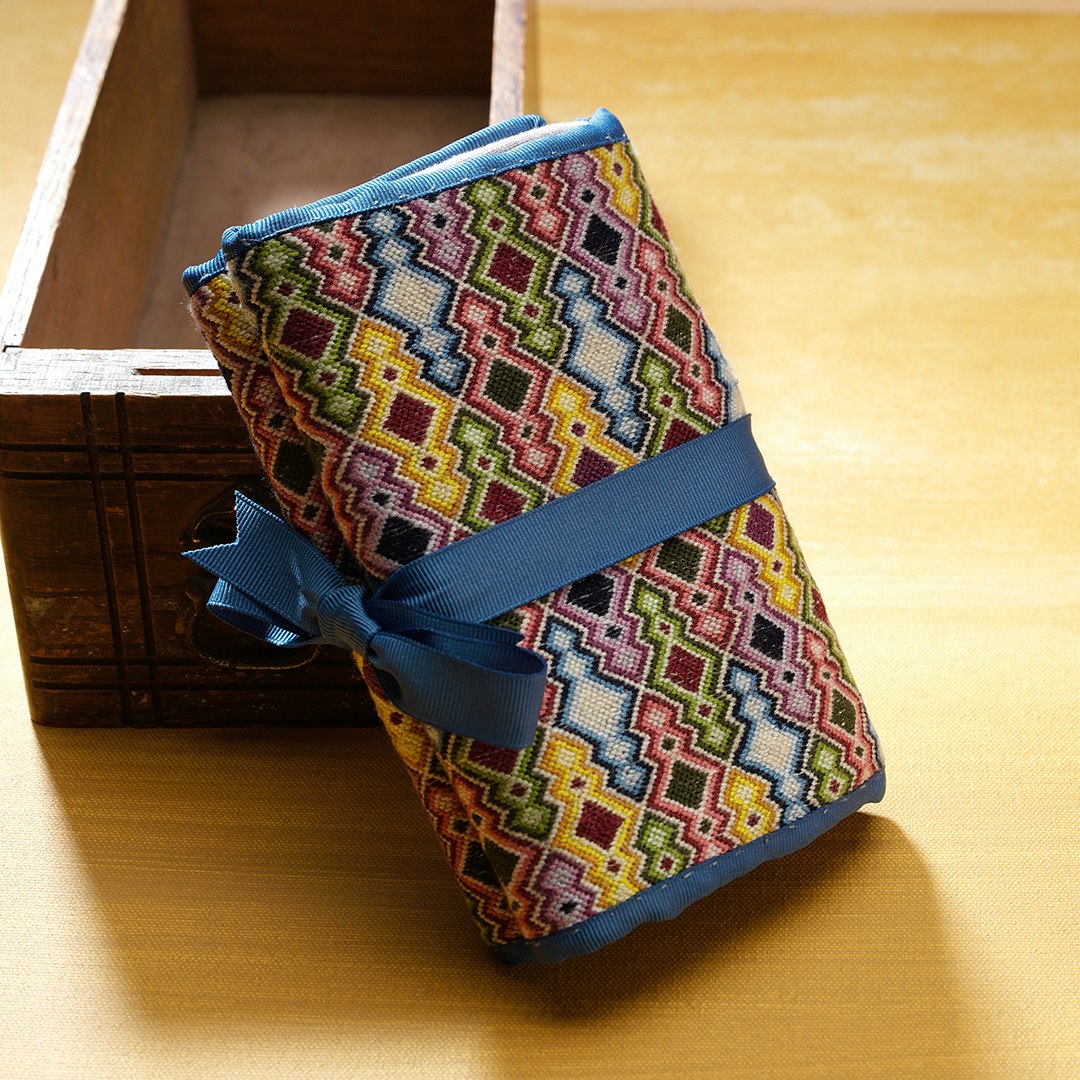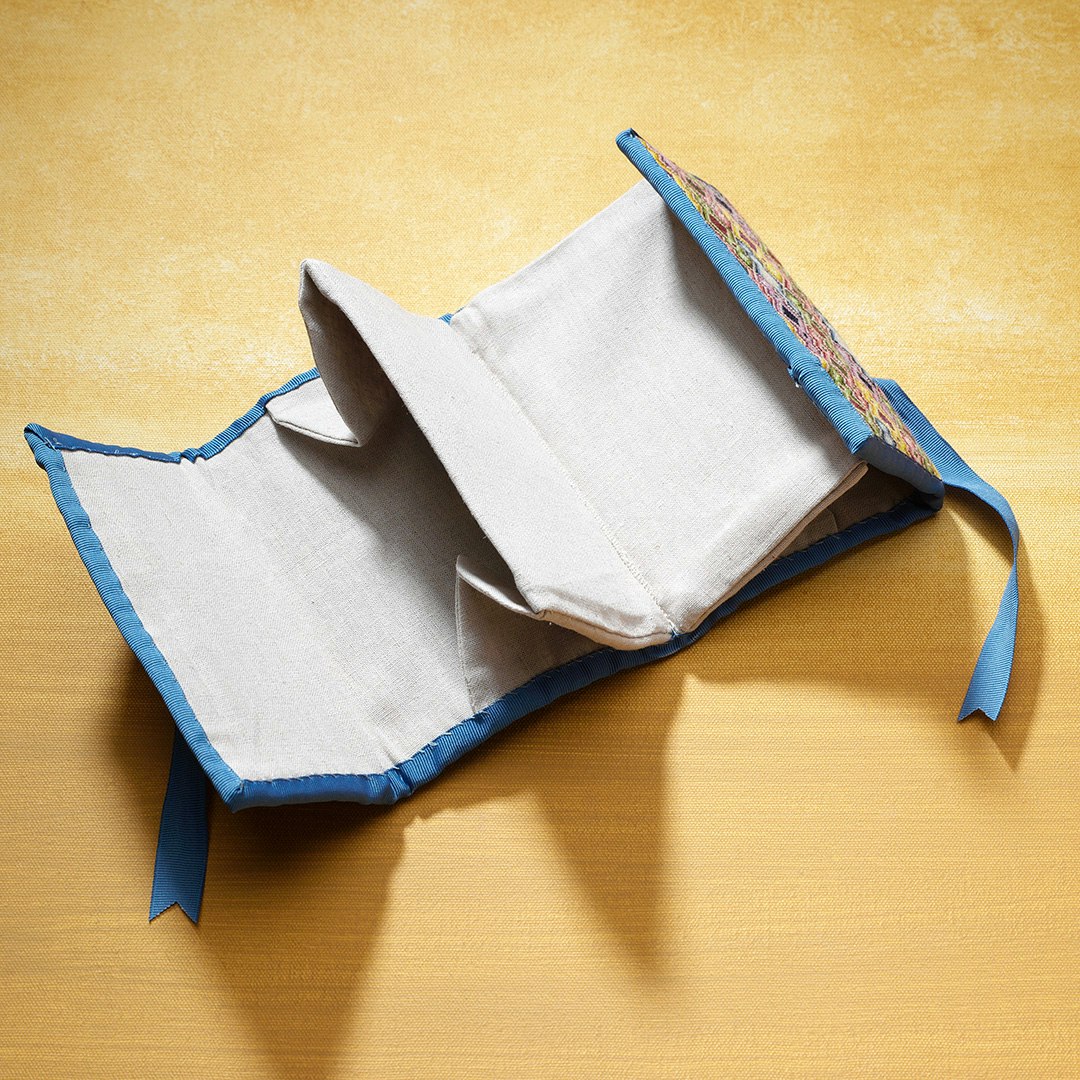Subscriber Exclusive
Sew a Pocketbook
Sew this delightful pocketbook with optional embroidered cover.
Sew this delightful pocketbook with optional embroidered cover. <a href="https://pieceworkmagazine.com/sew-a-pocketbook/">Continue reading.</a>
https://pieceworkmagazine.com/cdn-cgi/image/format=auto/https://www.datocms-assets.com/75076/1656651615-sixteen-miles-out-qsxa3aytovy-unsplash.jpg?auto=format&w=900
In the eighteenth century, pocketbooks carried by both men and women came in a variety of materials, from fine leathers to parchment to elaborate embroideries. Although these pocketbooks were often hidden away in a man’s coat pocket or in ladies’ pockets (frequently even more elaborately decorated and worn beneath their petticoats), the time and care taken to make these examples of beautiful, skillful needlework ensures their allure to this day.

The exterior of Karen W. MacGregor’s Irish-stitch pocketbook. Photo by Joe Coca
A Pocketbook to Sew
Notes: See “The Irish Stitch” (below) if you wish to make an Irish-stitch panel for the exterior of your pocketbook; if you wish to use another fabric, replace the 28-count linen called for in the pattern.
SUBSCRIBER EXCLUSIVE
In the eighteenth century, pocketbooks carried by both men and women came in a variety of materials, from fine leathers to parchment to elaborate embroideries. Although these pocketbooks were often hidden away in a man’s coat pocket or in ladies’ pockets (frequently even more elaborately decorated and worn beneath their petticoats), the time and care taken to make these examples of beautiful, skillful needlework ensures their allure to this day.

The exterior of Karen W. MacGregor’s Irish-stitch pocketbook. Photo by Joe Coca
A Pocketbook to Sew
Notes: See “The Irish Stitch” (below) if you wish to make an Irish-stitch panel for the exterior of your pocketbook; if you wish to use another fabric, replace the 28-count linen called for in the pattern.
[PAYWALL]
Materials
- Fabric, lightweight, 100% linen, natural, 1 piece 7 1/2 x 17 inches (19.1 x 43.2 cm) for the lining, 2 pieces 7 x 8 inches (17.8 x 20.3 cm) for the pockets, and 2 circles 9 inches (22.9 cm) in diameter for the gussets
- Timtex Stabilizer and Interfacing, white, 2 pieces 5 3/4 x 3 1/2 inches (14.6 x 8.9 cm) for the pockets and 1 piece 14 3/4 x 5 3/4 inches (37.5 x 14.6 cm) for the lining
- John James needle, sharp size 10
- Grosgrain ribbon, color of your choice, 3/4 inch (1.9 cm) wide, 1 piece 23 1/2 inches (59.7 cm) for the tie and 1 piece 54 inches (137.2 cm) for the binding
- Sewing thread, to match ribbon and natural

The interior of Karen’s pocketbook. Photo by Joe Coca
Finished Size: Open, 6 1/2 x 16 inches (16.5 x 40.6 cm); closed, 6 1/2 x 4 1/2 x 1 1/2 inches (16.5 x 11.4 x 3.8 cm).
Download Pocketbook Figure 1
Instructions
Notes: Unless otherwise noted, use a 1/2-inch (1.3-cm) seam allowance. Use the sewing thread that matches the ribbon when sewing the ribbon; use the natural sewing thread for all other stitching.
Cut each circle into quarters to make the gusset pieces. With right sides facing, sew two of the gusset pieces together along the curved edges, trim the seam allowance to 1/4 inch (6 mm), and clip the curve; turn right sides out and press. Repeat for the remaining gusset pieces. Turn the long sides of each of the linen pocket pieces under 1/2 inch (1.3 cm); fold each piece in half with wrong sides facing so that the raw edges are aligned, resulting in a 4- x 6-inch (10.2- x 15.2-cm) rectangle.
Insert one raw edge of one gusset piece 1/2 inch (1.3 cm) in one end of one pocket piece so that the rounded edge of the gusset piece is tucked inside the previously made fold in the pocket piece. Join the layers by slip-stitching from the fold in the pocket piece toward the point of the gusset piece; using another gusset piece, repeat on the other side of the pocket piece. Repeat for the remaining gusset and pocket pieces. Insert one small piece of stabilizer into the center of the open side of one of the pocket pieces; slide the stabilizer into the opening so that its long side meets the fold in the pocket piece. Turn under the raw edges of the pocket and gusset pieces 1/4 inch (6 mm) and press to enclose the stabilizer. Repeat with the other pocket piece and small piece of stabilizer.
With the gussets outstretched and referring to Figure 1, align the bottom edge of one pocket piece 1/8 inch (3 mm) to the left of the vertical centerline on the right side of the linen lining piece and centered top to bottom. To attach one pocket piece to the lining, whipstitch along the vertical centerline of the lining and bottom of the pocket piece.
Fold up the pocket piece, matching As, Bs, AAs, and BBs in Figure 1; the bottom edges of the gussets should be 3/4 inch (1.9 cm) from the raw edges of the lining and parallel to the long sides of the lining. Slip-stitch from A to AA and B to BB along the bottom edges of gussets to secure to the lining. The gussets should fold in at a 45-degree angle to allow the pocket to lay flat. Rotate Figure 1 180 degrees and repeat for the second pocket piece. Lay both pocket pieces flat and whipstitch the inside folded edges of both pockets together along the vertical centerline.
Layer and center the fabrics with a 7 1/2- x 17-inch (19.1- x 43.2-cm) piece of exterior fabric of your choice (for more information on the Irish-stitch fabric covering our sample, see the Irish Stitch sidebar below) face down, the remaining piece of stabilizer, and the lining with the pockets face up. Pin and baste the lining and exterior fabrics together along the outside edges of the stabilizer, being careful not to stitch the pockets down. Trim 1/2 inch (1.3 cm) off all layers to measure 6 1/2 x 16 inches (16.5 x 40.6 cm).
To bind, fold under 1/2 inch (1.3 cm) of one short end of the longest ribbon and carefully whipstitch one long edge of the ribbon to the outside of pocketbook about 1/4 inch (6 mm) from the raw edges, mitering the corners as you work. Trim the ribbon 1/2 inch (1.3 cm) beyond the beginning end, turn the end under, and secure. Fold the ribbon over the raw fabric edges and whipstitch the remaining ribbon edge to the inside of the pocketbook, being careful not to stitch down the pockets. Tack the center of the ribbon for the tie to the outside center fold of the pocketbook; trim the ends of the ribbon. Fold the ends of the pocketbook over the pockets, fold in half, and tie the ribbon.
The Irish Stitch
To Irish-stitch the exterior panel of the pocketbook, mount a 9- x 21-inch (22.9- x 53.3-cm) piece of 28-count linen in a needlework frame. Using the colors of your choice, three strands of embroidery thread, a size 28 tapestry needle, and working over four linen threads, stitch a design area that is 6 1/2 x 16 inches (16.5 x 40.6 cm). Outline shapes in a light color thread, and fill in each shape by starting with the darkest color and gradually moving to the lightest color in the center; refer to the chart for general shade gradation. I worked the sample shown here on Zweigart Cashel (28-count 100% linen fabric, #3281/222/55 Cream); it required ten skeins of ecru and five skeins each of fifteen colors of DMC embroidery floss (Article 117, 100% cotton 6-strand thread, 8.7 yards (8 m)/skein).
Download Pocketbook Chart. Chart courtesy of Karen W. MacGregor.
Karen W. MacGregor is a needlework author and designer in Pennsylvania.
Originally published December 2021; updated January 10, 2024.



